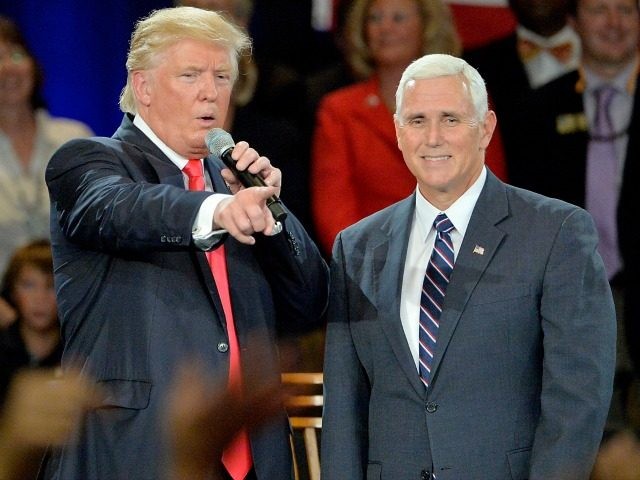GOP presidential nominee Donald J. Trump is riding a wave of momentum coming out last week’s Republican National Convention in Cleveland with a solid bump in the polls in his favor ranging from three to six percentage points.
The latest CNN-ORC International poll has Trump ahead of Hillary Clinton 48 to 45 percent, compared to their July 17 poll with Trump trailing the former first lady 42 percent to 49 percent, giving Trump a six-point pop with Clinton losing four points.
The CBS News poll released Monday had Trump ahead of Clinton 44 percent to 43 percent, but the CBS-New York Times July 14 poll had both candidates in a 40-to-40 tie. The Morning Consult poll, also released Monday, has Trump with a 44 percent to 40 percent lead, a shift from the Morning Consult poll released July 16 that had the two locked up with Trump at 39 percent to Clinton’s 41 percent.
Mona Chalabi wrote in the UK-based The Guardian that liberals should be seriously concerned about the movement in the polls that have moved in his favor, because he have been performing better in online polls compared to polls conducted with live operators. This gap points to a reluctance of voters to admit that they are supporting Trump to a live person, but without the personal interaction, so-called “Secret Trump Supporters”come out of shadows.
In the past week, Republican presidential nominee Donald Trump has risen 3.5 points in national polling averages. That might not sound like much, but it has been enough for him to nudge him 0.2 points ahead of Democrat Hillary Clinton. And Trump’s latest polling rise is particularly significant because it might be based on more honest survey respondents.
Chalabi wrote that as voters become more comfortable admitting their support of Trump, his polls will only get better. Before you dismiss, Chalabi as a confused foreign observer, note that she used to write for the polling and analytical site FiveThirtyEight.
The founder of FiveThirtyEight Nate Silver wrote that Trump was already on a roll before he touched down in Cleveland.
It isn’t straightforward to measure Trump’s convention bounce because he was already gaining ground on Clinton heading into the conventions, narrowing what had been a 6- to 7-point national lead for Clinton in June into roughly a 3-point lead instead.
Sliver wrote that it is very common for post-convention bounce to mask the reality of a losing campaign. “John McCain and Sarah Palin did so in 2008, for example, and even Walter Mondale led a couple of polls in 1984. But those bounces do not always turn out to be predictive.”
While the polls in the last three elections have been steadier than in other eras, Silver said that he sees the 2016 race taking on wilder swings that were seen in other times.
One of the interesting features on the site is their “now-cast,” which gives the chances of a candidate winning were the election held “today,” and according to the Monday’s FiveThirtyEight: “It suggests that in an election held today, Trump would be a narrow favorite, with a 57 percent chance of winning the Electoral College.”
In 2012, Republican nominee W. Mitt Romney was trailing President Barack Obama with 43 percent to the president’s 48 percent, two weeks before the Republican National Convention held the week of Aug. 27 in Tampa. In the week after the convention, Romney pulled up to Obama in a 48-to 48 percent tie. Romney fell back again the next week to 45 percent to Obama’s 48 percent. The race continued in that dynamic with the former Massachusetts governor finishing the race losing 48 percent to the reelected Obama’s 49 percent.
There have been huge post-convention bounces in the past. After the 1968 Republican convention, Richard M. Nixon picked up 14 points after his contested convention, where he beat back New York Gov. Nelson Rockefeller and California Gov. Ronald W. Reagan. On the other side to the aisle, Vice President Hubert H. Humphrey picked up three points after his convention, where the Chicago police waged jihad on anti-war protesters and the Chicago Mayor Richard Daley was leading floor demonstrations.
In recent memory, Arkansas Gov. William J. Clinton picked up 14 points after the Democratic convention, while President George H.W. Bush improved four points. The most significant event in the general election campaign was the candidacy of independent billionaire H. Ross Perot. Going into the Democratic convention, Bush led in the polls followed by Perot, then Clinton. But, during the convention Perot announced that he was dropping out of the race and supporting Clinton. After that shocker, Clinton shot to the lead and never trailed–even after Perot got back int0 the race.
It is important to note that national polls do not reflect how the election is actually decided, which is through the Electoral College and based on winning and losing individual states. In the case of California, Obama beat Romney 60 percent to 37 percent, or 7,854,285 to 4,839,958 for a margin of 3,014,327 votes. California’s 54 electoral votes were never in question for Obama, but the state represents 10 percent of the total votes cast. If a national poll includes Republican California voters, and in 2012 there were almost 5 million of them, the polls is going to be off because those votes have no impact on California or the eventual totals.

COMMENTS
Please let us know if you're having issues with commenting.